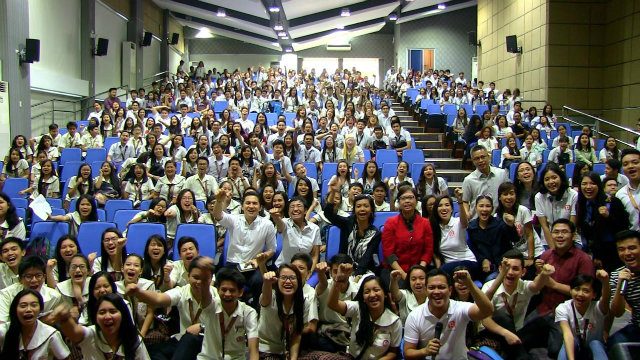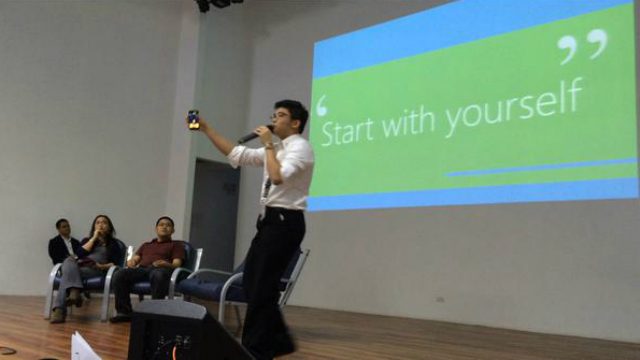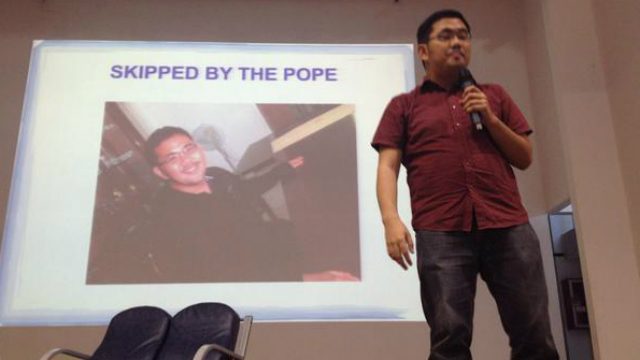SUMMARY
This is AI generated summarization, which may have errors. For context, always refer to the full article.

ANGELES CITY, Philippines – “Has anyone here paid a bribe?” Rappler CEO Maria Ressa asked over 500 college students on Monday, February 16. “Those small acts make our nation worse.”
“You have to find the courage to say no,” she added.
The veteran journalist opened #MovePampanga with a discussion on corruption, encouraging the students of Holy Angel University to lead the fight: “Your generation will do better than mine. Your generation can get rid of corruption.”
How? First you must know yourself, your society, and what integrity means to you.
Ressa shared her own bribe experience: $150,000 for a story.
“He told me no one will ever know. But I said no,” she shared. “If I accepted it, it would change me fundamentally and I would’t be able talk to you today.”
She advised the youth to draw the line between good and bad, “Once you cross the line, it’s harder to move back.”
Student leaders also asked for advice on juggling studies and extra-curricular activities. Ressa’s answer was simple: study and learn to balance your time.
“The only time you will not be criticized is if you do nothing,” Ressa said, advising students to learn to accept constructive criticism, while also being courageous.
Lastly, Ressa reminded students to aim high. “Don’t reach for money or position, be the best that you can be and don’t be afraid to fail.”

Big data, big change
In 2005, Gemma Bagayaua Mendoza exposed the wealth of the Ampatuans, the poverty of Maguindanao, and the killings surrounding it all.
The story was published in Newsbreak, an independent investigative magazine (now Rappler’s investigative reporting arm), and received little attention. Four years later, the Maguindanao massacre happened, and the whole world watched.
“What if they listened earlier? Maybe it would have not reached that point,” Mendoza thought. “But that time, our reach wasn’t big.”
Mendoza, now Rappler’s research and content strategy head, noted how technology makes storytelling faster: “You can tag news organizations and have direct, transparent communications.”
As of 2014, 38 million Filipinos have Internet access – one in every 9 Filipinos are on Twitter, and one out of 3 are one Facebook.
Mendoza is also part of Rappler’s Project Agos, a platform for disaster information.
“During Typhoon Sendong, people were reporting what was happening even before reporters got there,” she added. “Response, realtime action are faster.”
During Typhoon Mario, a local organization tweeted about a woman in labor stuck on a rooftop. Project Agos monitored the situation and linked the woman with Red Cross for rescue.
Mendoza said technology can also help harness stories from big data, just like in elections.

“But standards still apply: fact-checking, contextualizing, ensuring accountability,” she added.
Meanwhile, Eric Vincent Yumul of the Alliance of Legal Management Associations of the Philippines, reminded students to be the change they want to see.
He asked students to create a vision, “If it doesn’t work out, don’t give up, just rewrite it.”
Challenges, fun
Paterno Esmaquel II was Rappler’s lead reporter during Super Typhoon Yolanda (Haiyan) and the papal coverage. Ironically, he missed the action in both instances.
Esmaquel was isolated during Yolanda. “I was lost. We were told that Yolanda was going to make landfall in Borongan. By the time the storm changed its course, we didn’t have enough time. No one knew what would happen in Tacloban. We lost communication.”
He was supposed to cover Pope Francis’ visit in Palo, Leyte, but the Pope’s itinerary had last minute changes. “I only had a photo taken with a table where the Pope ate,” he said.
Did he miss the main stories? “No,” he said, “The main story was the people.”
For Esmaquel, journalists have 3 things to do: listen, teach, help.

Natashya Gutierrez, a Rappler multimedia reporter, discussed the “evolving roles” of journalists.
The challenge now, for Gutierrez, is to make sense of stories while also maintaining speed, accuracy, and openness to criticism.
She recalled how sources used to ignore her, thinking that Rappler was “just online.”
Story after story, however, she proved critiques wrong. She encouraged students to speak up courageously but also responsibly: “Journalism is never about the reporter, it’s about the people.”
But the most fun part of it all is being able to “make a difference,” the young journalist said.
Move
“If there are bad things people do online, there are also good things,” said Zak Yuson, head of MovePH, Rappler’s citizen engagement arm.
In the past years, MovePH has featured stories inspiring concrete action: people raising funds for relief efforts here and abroad, NGOs crowdfunding projects for the marginalized, and netizens helping expose anomalies.
“Each of us has that potential to do good,” Yuson said. “Social media is just a tool, it depends on how you use it.”
He encouraged the youth to write stories, volunteer for good causes, and to simply read and shares stories that can move others. – Rappler.com
Add a comment
How does this make you feel?
There are no comments yet. Add your comment to start the conversation.